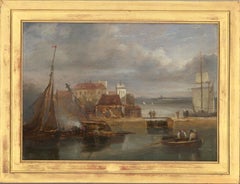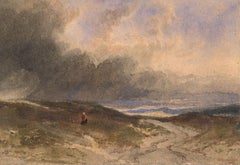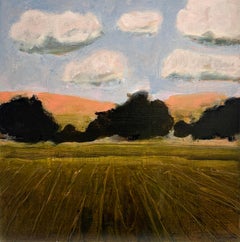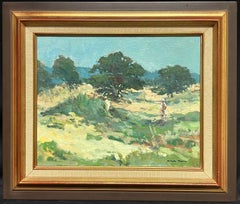James Wilson Carmichael Art
1800-1868
James Wilson Carmichael Growing up in Newcastle, he spent his youth watching the loading and unloading of the coal barges, and this time spent in the Dock's proved an everlasting source of inspiration for Carmichael. Carmichael was himself an apprentice to a shipbuilding firm after he returned from his travels to Spain and Portugal. His extensive understanding of ships allowed Carmichael to produce work that accurately captured the lives of the local workers and the surrounding harbors and docks of North East England.
to
2
2
Overall Width
to
Overall Height
to
2
2
2
1
1
1
2
1
1
2
10,138
2,779
1,375
1,367
2
Artist: James Wilson Carmichael
James Wilson Carmichael (1800-1868) - Signed Early 19th Century Oil, The Docks
By James Wilson Carmichael
Located in Corsham, GB
A very fine early 19th century oil by the eminent nautical painter James Wilson Carmichael (1800-1868). In this particular unfinished composition Carmichael has depicted a small dock...
Category
19th Century James Wilson Carmichael Art
Materials
Oil
James Wilson Carmichael (1800-1868) - 1852 Watercolour, By the Sea
By James Wilson Carmichael
Located in Corsham, GB
A delightful watercolour sketch depicting a lone figure walking towards the coastline. Signed and dated to the lower right. On paper.
Category
Mid-19th Century James Wilson Carmichael Art
Materials
Watercolor
Related Items
Field and Orchard (Land and Skyscape with Open Field and Dark Treeline)
By David Konigsberg
Located in Hudson, NY
Field and Orchard (Land and Skyscape with Open Field and Dark Treeline) by David Konigsberg
2025, oil on panel, 23.5 x 24 inches
Konigsberg is a conceptual realist who works across ...
Category
2010s Contemporary James Wilson Carmichael Art
Materials
Oil, Panel
$4,300
H 23.5 in W 24 in D 1.5 in
Bright Green Impressionist Landscape with Figure in Dunes Mid 20th Century
By Claude Marin
Located in Cirencester, Gloucestershire
Impressionist Landscape
by Claude Marin (French 1914-2001)
signed oil on canvas, framed
Framed: 19 x 22 inches
Canvas : 13.5 x 16.5 inches
Inscribed Verso
Provenance: private collect...
Category
Mid-20th Century Impressionist James Wilson Carmichael Art
Materials
Oil
Favorite Day (Abstracted Moody Landscape in Earth tones)
By David Konigsberg
Located in Hudson, NY
Favorite Day (Abstracted Moody Landscape in Earth tones) by David Konigsberg
2025, oil on panel, 24 x 32 inches
Konigsberg is a conceptual realist who works across media and paintin...
Category
2010s Contemporary James Wilson Carmichael Art
Materials
Oil, Panel
$5,100
H 24 in W 32 in D 1.5 in
18th Century Antique Oil Painting Coastal Harbor Scene with Towers Old Master
Located in Stockholm, SE
This captivating seascape presents a masterful coastal harbor scene from the 18th century, attributed to an unknown master of marine art. The composition is built around 2 watchtower...
Category
Late 18th Century Realist James Wilson Carmichael Art
Materials
Canvas, Wood, Walnut, Oil
$1,890
H 17.9 in W 22 in D 1 in
Family Portrait Mother with Children Playing Coins Framed Antique Oil Painting
Located in Stockholm, SE
Family genre scene late 19th early 20th century. The boy, tired of posing for a portrait painter, decided to play by spinning a coin on the table, this game greatly impressed his you...
Category
Early 20th Century Realist James Wilson Carmichael Art
Materials
Wood, Oil, Cardboard
$390
H 22.4 in W 28.7 in
Life in a Rustic Village Antique French Impressionist Oil Painting
Located in Cirencester, Gloucestershire
Rustic Village
Paul Molinard 19/ 20th Century French Artist
signed oil on panel, unframed
board : 10.5 x 14.5 inches
Inscribed verso
Provenance: private collection, France
Condition...
Category
Early 20th Century Impressionist James Wilson Carmichael Art
Materials
Oil
$1,201
H 10.5 in W 14.5 in
Colorful Cubist Portrait of Woman Holding Fruit Interior Scene Mid 20th Century
Located in Cirencester, Gloucestershire
Cubist Interior Scene
Marcel Seignobos (1892-1972)
signed oil on canvas, unframed
Canvas : 18 x 22 inches
Provenance: private collection, Cote d'Azur, France
Condition: good conditio...
Category
Mid-20th Century Cubist James Wilson Carmichael Art
Materials
Oil
From the Hammock (Abstracted Earth Tone Landscape)
By David Konigsberg
Located in Hudson, NY
From the Hammock (Abstracted Earth Tone Landscape)by David Konigsberg
2025, oil on panel, 23.5 x 24 inches
Konigsberg is a conceptual realist who works across media and painting gen...
Category
2010s Contemporary James Wilson Carmichael Art
Materials
Oil, Panel
$4,300
H 23.5 in W 24 in D 1.5 in
Fresh Cut (Abstracted Pink/Purple Flowers in Vase against Window)
By David Konigsberg
Located in Hudson, NY
Fresh Cut (Abstracted Pink/Purple Flowers in Vase against Window) by David Konigsberg
2023, oil on panel, 19 x 23 inches
Konigsberg is a conceptual realist who works across media an...
Category
2010s Contemporary James Wilson Carmichael Art
Materials
Oil, Panel
$3,200
H 19 in W 23 in D 1.5 in
Blacksmith (Untitled)
By Erle Loran
Located in Los Angeles, CA
Blacksmith (Untitled), 1936, oil on canvas, signed and dated lower right, 28 x 30 inches
Erle Loran was an influential American painter, art historian, and educator, renowned for h...
Category
1930s American Modern James Wilson Carmichael Art
Materials
Canvas, Oil
New Field (Landscape with Fluffy Clouds across a Vast Field)
By David Konigsberg
Located in Hudson, NY
New Field (Landscape with Fluffy Clouds across a Vast Field) by David Konigsberg
2025, oil on panel, 23.5 x 24 inches
Konigsberg is a conceptual realist who works across media and p...
Category
2010s Contemporary James Wilson Carmichael Art
Materials
Oil, Panel
$4,300
H 23.5 in W 24 in D 1.5 in
Vintage Swedish Figurative Unframed Oil Painting by Hans Osswald - The Pair
Located in Bristol, GB
THE PAIR
Size: 80 x 60.5 cm
Oil on Canvas
A large and very unique mid century modernist oil composition of two figures, painted onto canvas.
The artist has flattened the surface, r...
Category
1960s Abstract James Wilson Carmichael Art
Materials
Oil, Canvas
$947
H 31.5 in W 23.82 in
James Wilson Carmichael art for sale on 1stDibs.
Find a wide variety of authentic James Wilson Carmichael art available for sale on 1stDibs. You can also browse by medium to find art by James Wilson Carmichael in oil paint, paint and more. Not every interior allows for large James Wilson Carmichael art, so small editions measuring 17 inches across are available. Customers who are interested in this artist might also find the work of Dommersen, William Raymond, Adolphus Knell, and Jean-Baptiste-Antoine Guillemet. James Wilson Carmichael art prices can differ depending upon medium, time period and other attributes. On 1stDibs, the price for these items starts at $6,164 and tops out at $6,164, while the average work can sell for $6,164.



